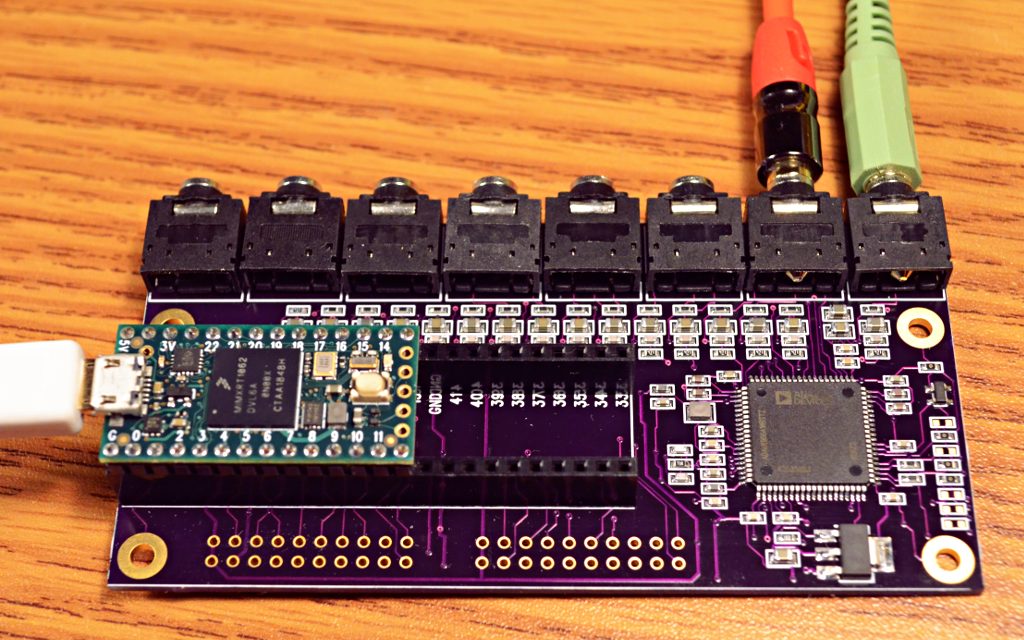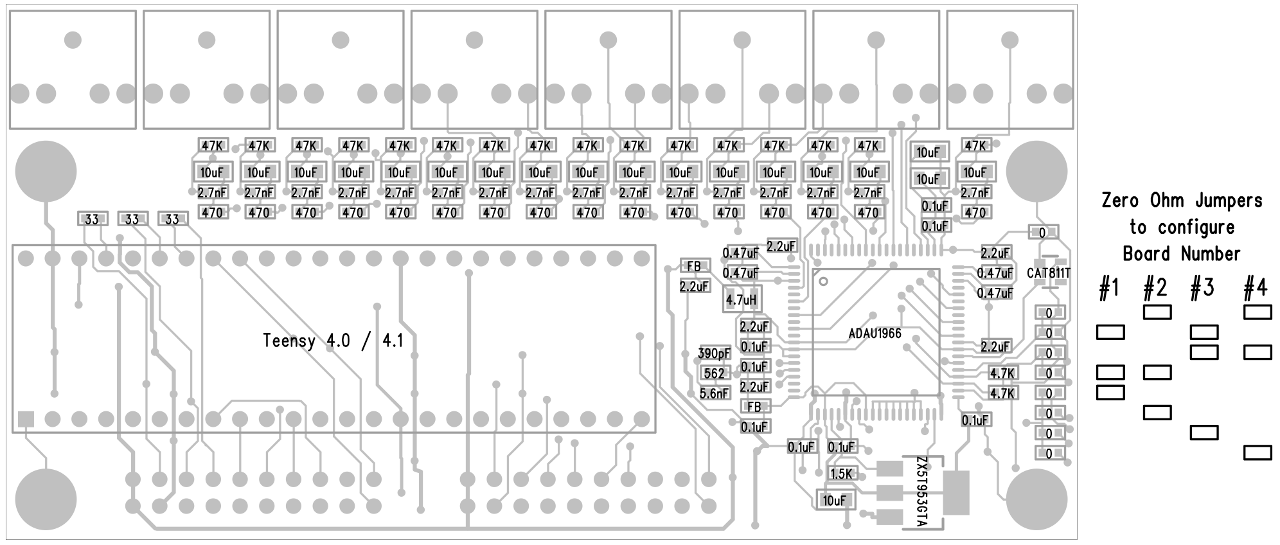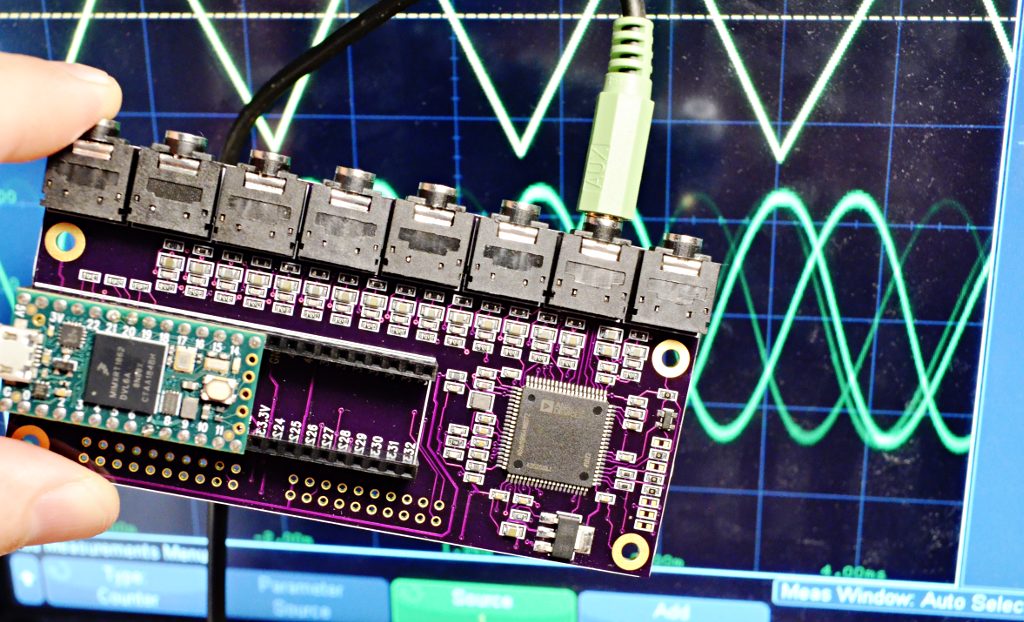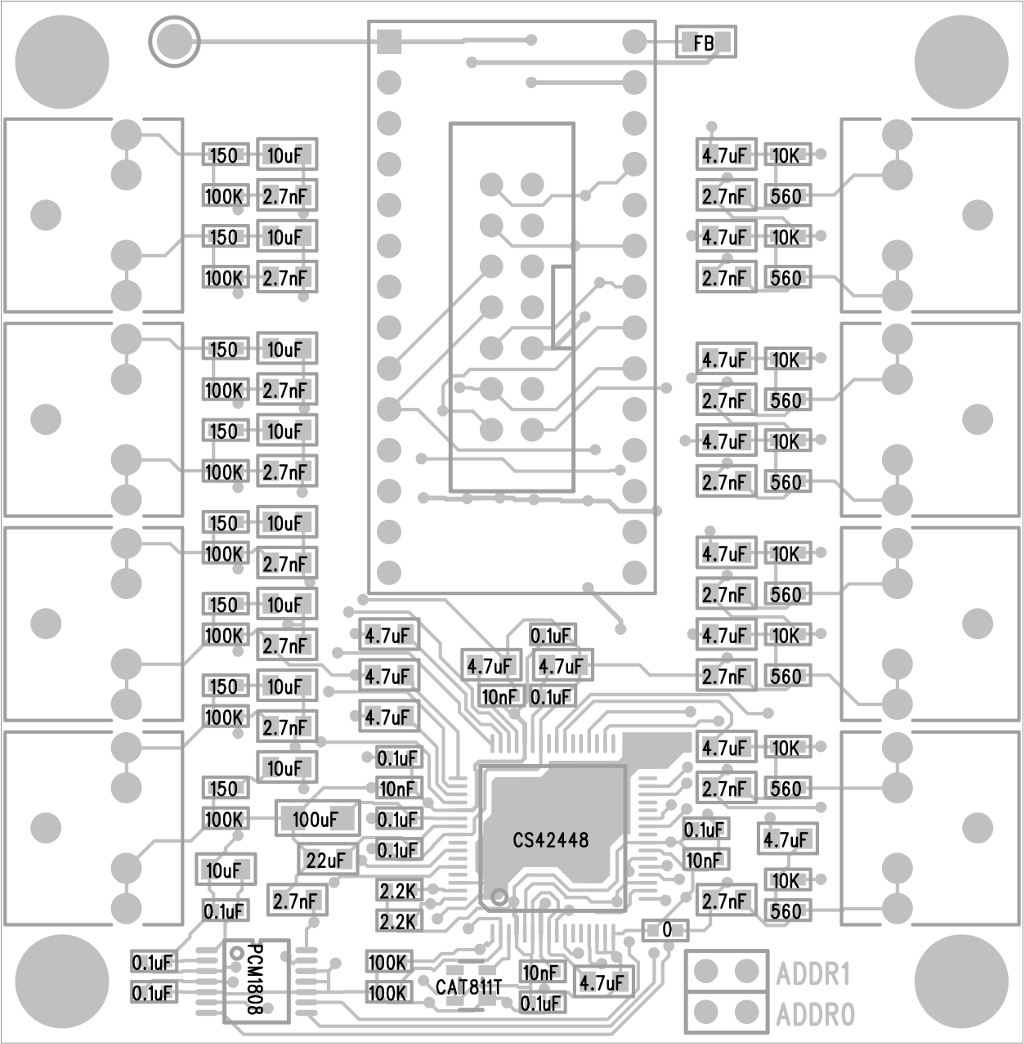
So far this PCB has only been tested with the code below. It does produce 16 different waveforms output with the correct frequencies and waveform shapes. The board seems to work, but no other testing has yet been done (or perhaps by the time you’re reading this, maybe this page is old info….)
Sharing this because it was requested on this Tweet.
https://twitter.com/insolace/status/1342452185552932864
This board uses the ADAU1966A chip from Analog Devices. Analog Devices also made an older version of this chip, ADAU1966 without the “A”. It is listed as not recommended for new designs. If you search and find the old chip, don’t worry. Just make sure you’re searching for ADAU1966A with the “A”.

#include <Audio.h>
#include <Wire.h>
// GUItool: begin automatically generated code
AudioSynthWaveform waveform6; //xy=220,287
AudioSynthWaveform waveform5; //xy=221,250
AudioSynthWaveform waveform7; //xy=221,325
AudioSynthWaveform waveform2; //xy=222,134
AudioSynthWaveform waveform10; //xy=221,437
AudioSynthWaveform waveform1; //xy=223,97
AudioSynthWaveform waveform8; //xy=222,363
AudioSynthWaveform waveform9; //xy=222,400
AudioSynthWaveform waveform3; //xy=223,172
AudioSynthWaveform waveform11; //xy=222,475
AudioSynthWaveform waveform4; //xy=224,210
AudioSynthWaveform waveform12; //xy=223,513
AudioSynthWaveform waveform14; //xy=223,588
AudioSynthWaveform waveform13; //xy=224,551
AudioSynthWaveform waveform15; //xy=224,626
AudioSynthWaveform waveform16; //xy=225,664
AudioOutputTDM tdm1; //xy=524,345
AudioConnection patchCord1(waveform6, 0, tdm1, 5);
AudioConnection patchCord2(waveform5, 0, tdm1, 4);
AudioConnection patchCord3(waveform7, 0, tdm1, 6);
AudioConnection patchCord4(waveform2, 0, tdm1, 1);
AudioConnection patchCord5(waveform10, 0, tdm1, 9);
AudioConnection patchCord6(waveform1, 0, tdm1, 0);
AudioConnection patchCord7(waveform8, 0, tdm1, 7);
AudioConnection patchCord8(waveform9, 0, tdm1, 8);
AudioConnection patchCord9(waveform3, 0, tdm1, 2);
AudioConnection patchCord10(waveform11, 0, tdm1, 10);
AudioConnection patchCord11(waveform4, 0, tdm1, 3);
AudioConnection patchCord12(waveform12, 0, tdm1, 11);
AudioConnection patchCord13(waveform14, 0, tdm1, 13);
AudioConnection patchCord14(waveform13, 0, tdm1, 12);
AudioConnection patchCord15(waveform15, 0, tdm1, 14);
AudioConnection patchCord16(waveform16, 0, tdm1, 15);
AudioControlCS42448 cs42448_1; //xy=554,546
// GUItool: end automatically generated code
#define ADAU1966A_PLL_CLK_CTRL0 0x00
#define ADAU1966A_PLL_CLK_CTRL1 0x01
#define PDN_THRMSENS_CTRL_1 0x02
#define ADAU1966A_DAC_CTRL0 0x06
#define ADAU1966A_DAC_CTRL1 0x07
#define ADAU1966A_DAC_CTRL2 0x08
uint8_t i2c_addr = 0x04;
bool write(uint8_t address, uint32_t data) {
Wire.beginTransmission(i2c_addr);
Wire.write(address);
Wire.write(data);
if (Wire.endTransmission() != 0) return false;
return true;
}
uint8_t read(uint8_t address) {
Wire.beginTransmission(i2c_addr);
Wire.write(address);
if (Wire.endTransmission(false) != 0) return 0;
if (Wire.requestFrom((int)i2c_addr, 1) < 1) return 0;
return Wire.read();
}
// 1. Apply power to the ADAU1966A
// 2. Assert the PU/RST pin high after power supplies are stable.
// 3. Set the PUP bit to 1.
// 4. Program all necessary registers for the desired settings.
// 5. Set the MMUTE bit to 0 to unmute all channels.
bool adau1966_begin() {
Wire.begin();
// 3. Set the PUP bit to 1. (also disable crystal oscillator)
if (!write(ADAU1966A_PLL_CLK_CTRL0, 0x00110101)) return false;
// 4. Program all necessary registers for the desired settings.
// using external MCLK
// set MCLK from MCLKI or XTALI
if (!write(ADAU1966A_PLL_CLK_CTRL1, 0b00110011)) return false;
// When using the ADAU1966A in direct master clock mode, power
// down the PLL in the PDN_THRMSENS_CTRL_1 register.
if (!write(PDN_THRMSENS_CTRL_1, 0b00100010)) return false;
// TDM16 needs LRCLK_MODE set to pulse
if (!write(ADAU1966A_DAC_CTRL1, 0b01000000)) return false;
// TDM16 needs 16 bits per slot
if (!write(ADAU1966A_DAC_CTRL2, 0b00010000)) return false;
// 5. Set the MMUTE bit to 0 to unmute all channels.
// sets TDM16 mode
if (!write(ADAU1966A_DAC_CTRL0, 0b00100000)) return false;
return true;
}
void setup() {
AudioMemory(50);
//cs42448_1.enable();
//cs42448_1.volume(1.0);
while (!Serial) ;
Serial.println("ADAU1966A Test");
if (adau1966_begin()) {
Serial.println("configured ADAU1966A");
} else {
Serial.println("failed to config ADAU1966A");
if (cs42448_1.enable() && cs42448_1.volume(1.0)) {
Serial.println("configured CS42448");
} else {
Serial.println("failed to config CS42448");
}
}
waveform1.begin(0.95, 207.65, WAVEFORM_TRIANGLE);
waveform2.begin(0.95, 220.00, WAVEFORM_SINE);
waveform3.begin(0.95, 233.08, WAVEFORM_SAWTOOTH);
waveform4.begin(0.95, 246.94, WAVEFORM_SQUARE);
waveform5.begin(0.95, 261.63, WAVEFORM_TRIANGLE);
waveform6.begin(0.95, 277.18, WAVEFORM_SINE);
waveform7.begin(0.95, 293.66, WAVEFORM_SAWTOOTH);
waveform8.begin(0.95, 311.13, WAVEFORM_SQUARE);
waveform9.begin(0.95, 329.63, WAVEFORM_TRIANGLE);
waveform10.begin(0.95, 349.23, WAVEFORM_SINE);
waveform11.begin(0.95, 369.99, WAVEFORM_SAWTOOTH);
waveform12.begin(0.95, 392.00, WAVEFORM_SQUARE);
waveform13.begin(0.95, 415.30, WAVEFORM_TRIANGLE);
waveform14.begin(0.95, 440.00, WAVEFORM_SINE);
waveform15.begin(0.95, 466.16, WAVEFORM_SAWTOOTH);
waveform16.begin(0.95, 493.88, WAVEFORM_SQUARE);
}
void loop() {
}


















